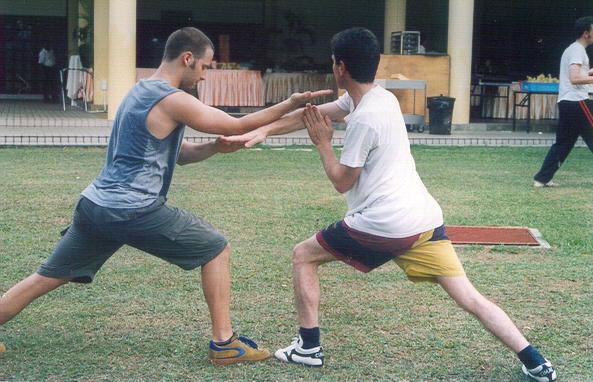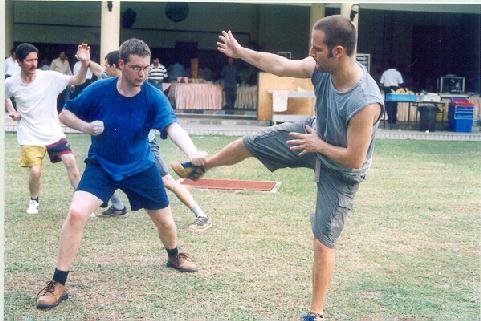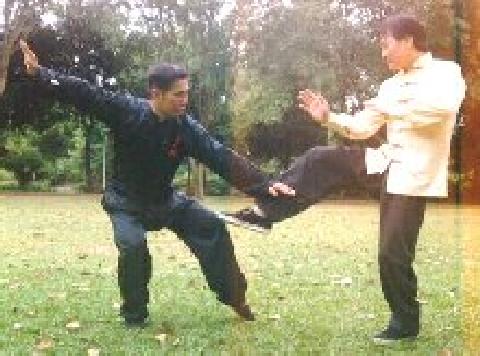December 2004 (Part 3)
SELECTION OF QUESTIONS AND ANSWERS

Blocking is an inferior way to defend. There are many better ways. During a sparring practice in an Intensive Shaolin Kungfu Course in Malaysia, Roland deflected (not blocked) Kevin's palm strike and, continuing the deflecting movement, counter attacked at Kevin's throat before Kevin could withdraw his attacking hand.
Question 1
Is it possible to train your mind to react to someone throwing fists at you? I know you will have to train to be able to block these.
— Drew, USA
Answer
Of course it is possible. The highest kungfu involves mind.
Blocking fists is only one way of defence, and is not the best or the most advanced way. There are other ways of defence or counter-attack which do not require blocking.
Question 2
I've been studying a lot of arts in fighting. I noticed in one of my fights a while back that after I had calmed down I could really see the punches being thrown and was able to block them, but since I have such a bad temper most of the time I snap and hardly use any styles I know. I just don't really even think about any of my hits or concentrate on them.
Answer
Being calm and relaxed is essential, not just preferred, if you wish to be a good fighter. When you are calm and relaxed, not only you can see punches and other attacks clearly and be able to handle them effectively, you can also do all other things more effectively. Some examples of these other things include at which part of his arm and at what point in time you wish to block, or what other techniques and how much force you wish to use if you prefer not to block.
If you have a bad temper, you should first tame your temper by practicing appropriate exercises. Mind training is an excellent approach for this purpose. In Chinese, the term for “mind” is “xin”, which is often translated as “heart”. “Xin” includes the emotional, the intellectual as well as the spiritual aspects of the “mind”.
If you do not use any styles you know, do not think about your hits or concentrate on them, despite your having studied a lot of fighting arts, then your training, if any, is unmethodical and a waste of time and effort. Have you ever seriously considered why you practice or study fighting arts? If you haven't, you are in good company; most martial art students today do not have any clear aims and purposes in their training or study!
Question 3
Now as I've studied more into it my fighting doesn't look like kid fighting. It has a lot more control but I still can't seem to use any fighting art.
Answer
No matter how much and for how long you study fighting arts, if you do not practice sparring methodically, your fighting will still be kid fighting.
This is the situation of the great majority of those who practice kungfu or wushu today, including “masters”. They can perform beautiful kungfu or wushu forms in solo, but can never apply their forms in fighting or even sparring. If you only study but never practice, you may not even fight like a kid.

Instead of blocking Roland's kick, Don withdrew his front leg and simultaneously struck Roland's ankle with a “hanging fist” employing the Shaolin pattern “Lohan Strikes Drum” just as the kick is spent, during sparring practice in an Intensive Shaolin Kungfu Course in Malaysia.
Question 4
I'm not really asking you to teach me to fight because I know you have to have your mind set mentally first. Meditation is a way to improve concentration on certain skills but it doesn't help when in an actual defense mode.
And the thing about knowing your enemy you really can't do that if someone jumps at you from nowhere. That really doesn't give you enough time to think about who you're fighting or how you're going to win. But there is something I'm looking for is like a hole I'm trying to fix. It's a feeling that seems to drive me crazy. I can't quite solve it. Most of the fighting art teachers teach moves but none of them teach the mental part and I believe that's what I'm missing. Any advice or help you could give would be appreciated a lot.
Answer
My advice is simple, direct and effective, and is in two steps. One, stop intellectualizing. Two, learn from a master or at least a competent instructor.
The elaboration of my advice may not he pleasant for you to hear, but it is given sincerely and for your benefit if you appreciate it.
It is obvious that you have no exposure to both the philosophy and the practice of good martial arts. You form your opinions based on your limited experience and knowledge, but regard them as facts and deliver them as if you were an expert.
Let us have fun as well as benefit by analyzing what you said.
“I'm not really asking you to teach me to fight because I know you have to have your mind set mentally first.”
This sentence suggests that you were confused. You did not know exactly what you wanted to say. Meditation, if practiced correctly, will help you to overcome this problem.
“Meditation is a way to improve concentration on certain skills but it doesn't help when in an actual defense mode”
The first part of your sentence is right, although there are much more meditation can do. The second part is wrong. Meditation is very helpful when you are in an actual defense mode.
“And the thing about knowing your enemy you really can't do that if someone jumps at you from nowhere.”
Meditation enables you to know your enemy well, including if he jumps at you from nowhere.
“That really doesn't give you enough time to think about who you're fighting or how you're going to win”
A good fighter well trained in meditation can “freeze” time during combat, so that a split second in normal time may appear like a few seconds in a meditative state of mind, called Zen in Shaolin Kungfu. A well-trained Shaolin fighter does not think during combat! He fights spontaneously and extremely effectively in a state of Zen.
“But there is something I'm looking for is like a hole I'm trying to fix. It's a feeling that seems to drive me crazy. I can't quite solve it.”
Meditation training under the guidance of a competent teacher will help you to solve such problems. Meditation on your own incorrectly or taught by incompetent teachers will make your problems worse.
“Most of the fighting art teachers teach moves but none of them teach the mental part and I believe that's what I'm missing”.
Today most fighting art teachers not only do no teach the mental part, they also do not teach the physical part of fighting (they only teach fighting moves for solo demonstration). If they did, their students would not routinely hurt themselves in sparring.
You (and most fighting art students today) are missing not just the mental part, but many of the wonderful benefits of practicing a fighting art, such as good self-defence (which includes not being hurt in sparring), good health (not likely if you sustain internal injuries from sparring), mental clarity (which you lack if you cannot present your points clearly), as well as the philosophy and the methodology of the arts you practice (which you also lack, as revealed in your questions).
But you are wrong to say that no teachers today teach the mental part as well as the other wonderful aspects of fighting arts. These teachers are rare, no doubt, and obviously you have not met any of them yet.
Question 5
I read your answer about counting leaves, Question 5 of July 2004 Part 2. I wish to know whether we should wear glasses when we are counting leaves?
— Kiat, Malaysia
Answer
You can count the leaves with your naked eyes, or wearing glasses, or do both at different times. But it is best to do so with naked eyes.
Start at a comfortable distance where you can count the leaves without the aid of glasses. (For some persons this may be quite near). Gradually increase the distance as the eye-sight improves.
More information about the eye exercises can be found at Question 4 of the October 2004 Part 2.
Question 6
I have practiced traditional Yang Style Taijiquan for 4 and a half years. Usually, I do one or two long forms (103 postures) every day. Sometimes during the form, I feel “something” (I believe it is qi) that runs along my arms. This happens more often in some postures like “Lou Xi Ao Bu” (“Turn Knee Bend Step”), “Ye Ma Fen Zong” (Wild Horse Separate Mane”), and in “Pushing” of “Grasping Sparrow's Tail”.
— Cesar, Venezuela
Answer
Congratulations, your dedicate practice has born fruit. What you experience is qi (chi). Some patterns, especially where there are hand movements extending out, like the ones you have mentioned, enable qi to flow more easily and be more readily noticeable.
You have been successful in generating qi flow because you have performed the patterns in relaxed and graceful movements while in a meditative state of mind. Qi can be generated in three main approaches, namely form, breathing and mind.
In your case, you have generated qi by performing various appropriate patterns (form) continuously. There is no need to worry about breathing and visualization, but you must let your breathing be spontaneous and gentle, and your mind be relaxed and thinking of nothing — as you have successfully done.
If you wish to enhance your qi flow, the following exercises are helpful. They are safe to be practiced on your own.
Stand upright and be totally relaxed. Then repeat just “Turn Knee Bend Step” (called “Green Dragon Shoots Pearl” in our school) or “Wild Horse Separate Mane” on one side about 20 times on the same spot, that is, without moving away your feet.
Your movements must be gentle and graceful, and you must not think of anything. Don't worry about your breathing, just breath naturally. You are to be rooted to the ground below but flowing like clouds above.
After about 20 repetitions on one side, perform the same pattern about 20 times on the other side. (Remember to adjust your foot position as you change your Bow-Arrow Stance from one side to the other.)
After performing the same pattern about 40 times (20 times on each side), bring both feet together, stand upright, and be totally relaxed. If you sway gently, enjoy your qi flow. If you are quite still, enjoy qi building at your dan tian.
After you have practiced the above exercise for some time (say, for three months) at the “stationary mode”, you may progress to the “moving mode”. One way is as follows.
Imagine you face north. (You do not actually have to face north, but compass points are given here for convenience to show directions.) From standing position, move north to a left Bow-Arrow Stance and perform “Turn Knee Bend Step” or “Wild Horse Separates Mane” once. Then move your back leg forward into a right Bow-Arrow Stance and perform the same pattern but with the other hands once.
Repeat many times moving forward towards north. Then turn around and repeat the same pattern moving towards south. After repeating the pattern about 40 to 50 times (with both the left and right modes), return to the original position facing north, stand upright and be totally relaxed. Enjoy your qi flow or qi building at your dan tian.
Another way is to move forward diagonally in north-west and north-east directions, then turn around in south-east and south-west directions. A third way is to move in north, south, east, west directions. When you are familiar with the footwork, you can move in any direction.

Combat application is an essential aspect of genuine, traditional Taijiquan. Sifu Wong employs the combat principle of “no defence direct counter” in response to Goh Kok Hin's organ-seeking kick. Without blocking the kick, Sifu Wong withdraws his front leg into a False-Leg Stance and simultaneously strikes the kicking leg using the Taijiquan pattern “White Crane Flaps Wing”.
Question 7
When I am beginning or finishing the form, and doing the movement of lowering the arms, i.e., “Beginning Form” (“Qi Shi”) and “Closing Form” (“Shou Shi”) respectively, I feel a huge current of “something” sinking down into my dantian. It is like a river lowering along the center of my body, and it stops at the dantian. Is this qi?
Answer
Yes, it is qi. The beginning form is another excellent way to develop qi or internal force. Instead of performing it twice, as it is normally done in form practice, you can perform just this pattern 20 times. Then conclude the training with the “Closing Form” by bringing your feet together and bringing your hands in a big circle above your head, then down the front of your body to your dan tian. Stand upright and be totally relaxed, and enjoy your qi flow or qi building at your dan tian.
The beginning form is called “Lifting Water”, and the closing form “Qi Returning to Dan Tian”. Gradually increase the number of repetitions of “Lifting Water” to 50 times, and if you wish, to 300 times. Note the key word “gradually”.
While this exercise of “Lifting Water” to develop qi is relatively safe, muscular tension and mental stress can cause adverse side effects. Judging from your practice revealed in your e-mail, this exercise should be safe for you to practice on your own. But bear in mind my following advice. Don't add anything extra to what I have described. For example, don't add weights to your arms or imagine colorful qi entering your body, as some smart Alex might do. And don't chase after the effects. Just practice the exercise and enjoy it. If you practice daily, you may be amazed at the results in six months.
Question 8
And if it is qi, why I am not able to feel the qi during the whole form? Do I need more practice? What should I do? I would really appreciate your answer, Sifu.
Answer
The main reason why you only feel qi at the beginning and ending, and while performing certain patterns like “Turn Knee Bend Step” and “Wild Horse Separates Mane”, and not during the whole form, is that these particular patterns are the ones specially meant to develop qi, whereas other patterns are meant for other purposes.
Another possible reason is that, due to various factors, you are relaxed and in a meditative state of mind while performing these patterns, whereas while performing the other patterns of the form, you are not in required state for generating qi.
What you need is not more practice in terms of time spent but better practice in terms of quality training. If you understand what you are doing, and can be in a qigong state of mind during practice, you can have better results even if you spend less time and effort in your training. It was not uncommon for people to tell me that they gained more benefits in a few days of my intensive courses than many years of their previous practice. It is understandable if other people do not believe this, but it is true.
What you should do, depends much on what you would like to get from your training as well as how much sacrifice you are prepared to put into it.
If you are quite satisfied with what you are currently getting, you should continue as you have been doing, but with the following modification. Instead of practicing two long forms, practice just one form a day (you can practice the other form another day), then practice one or more of the exercises I have explained above. If you are short of time, you can alternate between practicing a form one day, and my recommended exercises another day.
But if you wish to get more from your Taijiquan training, you would have to make some basic changes. You may, for example, change your philosophical perspective of practicing Taijiquan as a recreation hobby to practicing Taijiquan as an internal martial art. Now, even as a hobby, you are practicing Taijiquan not just as an external dance but as an internal art, as you have successfully generated qi or internal force. But the martial dimension is still missing in the “internal-martial” equation of Taijiquan.
Once you understand that genuine, traditional Taijiquan is an internal martial art, you would be in a better position to set your goals and train towards your goals. You would, for example, study principles, acquire skills and apply techniques to combat, and not merely perform forms, even though the forms can generate qi. You must also realize that the main goals of practicing Taijiquan as an internal martial art are not just to make you into a good fighter, but to derive the best benefits that practicing Taijiquan can give, that enrich your live and the lives of others.
LINKS
Selected Reading
- Practsing Chi Kung for High-Atitude Mountain Climbing — Dr. Paul Stocker
- Excellent Exercise to Overcome Cancer — Pilar Fernandez
- Experiencing Satori at the Blue Mountain — Laura Fernández Garrido
- Enjoying Nature, the Evening Colours, the Wind, the Birds Singing — Inge Vandromme
- Why Shaolin Kungfu is the Greatest Martial Art
